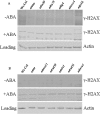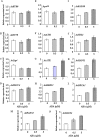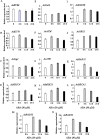Homologous Recombination Defective Arabidopsis Mutants Exhibit Enhanced Sensitivity to Abscisic Acid
- PMID: 28046013
- PMCID: PMC5207409
- DOI: 10.1371/journal.pone.0169294
Homologous Recombination Defective Arabidopsis Mutants Exhibit Enhanced Sensitivity to Abscisic Acid
Abstract
Abscisic acid (ABA) acts as an important plant hormone in regulating various aspects of plant growth and developmental processes particularly under abiotic stress conditions. An increased ABA level in plant cells inhibits DNA replication and cell division, causing plant growth retardation. In this study, we have investigated the effects of ABA on the growth responses of some major loss-of-function mutants of DNA double-stand break (DSB) repair genes in Arabidopsis during seed germination and early stages of seedling growth for understanding the role of ABA in the induction of genome instability in plants. A comparative analysis of ABA sensitivity of wild-type Arabidopsis and the knockout mutant lines related to DSB sensors, including atatm, atatr, the non-homologous end joining (NHEJ) pathway genes, and mutants related to homologous recombination (HR) pathway genes showed relatively enhanced sensitivity of atatr and HR-related mutants to ABA treatment. The expression levels of HR-related genes were increased in wild-type Arabidopsis (Col-0) during seed germination and early stages of seedling growth. Immunoblotting experiments detected phosphorylation of histone H2AX in wild-type (Col-0) and DSB repair gene mutants after ABA treatment, indicating the activation of DNA damage response due to ABA treatment. Analyses of DSB repair kinetics using comet assay under neutral condition have revealed comparatively slower DSB repair activity in HR mutants. Overall, our results have provided comprehensive information on the possible effect of ABA on DNA repair machinery in plants and also indicated potential functional involvement of HR pathway in repairing ABA induced DNA damage in Arabidopsis.
Conflict of interest statement
The authors have declared that no competing interests exist.
Figures










Similar articles
-
Abscisic acid suppresses the highly occurred somatic homologous recombination in Arabidopsis rfc1 mutant.J Genet Genomics. 2013 Sep 20;40(9):465-71. doi: 10.1016/j.jgg.2013.05.006. Epub 2013 Jun 10. J Genet Genomics. 2013. PMID: 24053948
-
Isolation and characterization of novel mutant loci suppressing the ABA hypersensitivity of the Arabidopsis coronatine insensitive 1-16 (coi1-16) mutant during germination and seedling growth.Plant Cell Physiol. 2012 Jan;53(1):53-63. doi: 10.1093/pcp/pcr174. Epub 2011 Dec 12. Plant Cell Physiol. 2012. PMID: 22156383
-
The Arabidopsis thaliana ABSCISIC ACID-INSENSITIVE8 encodes a novel protein mediating abscisic acid and sugar responses essential for growth.Plant Cell. 2004 Feb;16(2):406-21. doi: 10.1105/tpc.018077. Epub 2004 Jan 23. Plant Cell. 2004. PMID: 14742875 Free PMC article.
-
DNA recombination in somatic plant cells: mechanisms and evolutionary consequences.Chromosome Res. 2014 Jun;22(2):191-201. doi: 10.1007/s10577-014-9415-y. Chromosome Res. 2014. PMID: 24788060 Review.
-
Seeing 'cool' and 'hot'--infrared thermography as a tool for non-invasive, high-throughput screening of Arabidopsis guard cell signalling mutants.J Exp Bot. 2004 May;55(400):1187-93. doi: 10.1093/jxb/erh135. Epub 2004 Apr 8. J Exp Bot. 2004. PMID: 15073209 Review.
Cited by
-
Enhancing HR Frequency for Precise Genome Editing in Plants.Front Plant Sci. 2022 May 3;13:883421. doi: 10.3389/fpls.2022.883421. eCollection 2022. Front Plant Sci. 2022. PMID: 35592579 Free PMC article.
-
SOG1 transcription factor promotes the onset of endoreduplication under salinity stress in Arabidopsis.Sci Rep. 2021 Jun 2;11(1):11659. doi: 10.1038/s41598-021-91293-1. Sci Rep. 2021. Retraction in: Sci Rep. 2024 Feb 21;14(1):4282. doi: 10.1038/s41598-024-54831-1. PMID: 34079040 Free PMC article. Retracted.
-
Arabidopsis Histone Variant H2A.X Functions in the DNA Damage-Coupling Abscisic Acid Signaling Pathway.Int J Mol Sci. 2024 Aug 16;25(16):8940. doi: 10.3390/ijms25168940. Int J Mol Sci. 2024. PMID: 39201623 Free PMC article.
-
Hallmarks of DNA Damage Response in Germination Across Model and Crop Species.Genes (Basel). 2025 Jan 17;16(1):95. doi: 10.3390/genes16010095. Genes (Basel). 2025. PMID: 39858642 Free PMC article. Review.
-
The Plant DNA Damage Response: Signaling Pathways Leading to Growth Inhibition and Putative Role in Response to Stress Conditions.Front Plant Sci. 2019 May 17;10:653. doi: 10.3389/fpls.2019.00653. eCollection 2019. Front Plant Sci. 2019. PMID: 31164899 Free PMC article. Review.
References
MeSH terms
Substances
LinkOut - more resources
Full Text Sources
Other Literature Sources
Molecular Biology Databases

